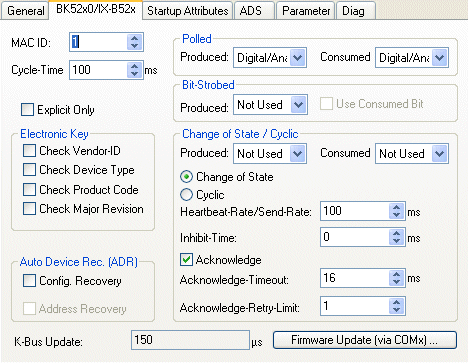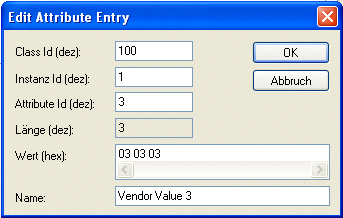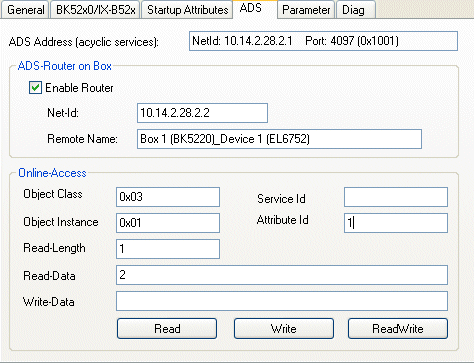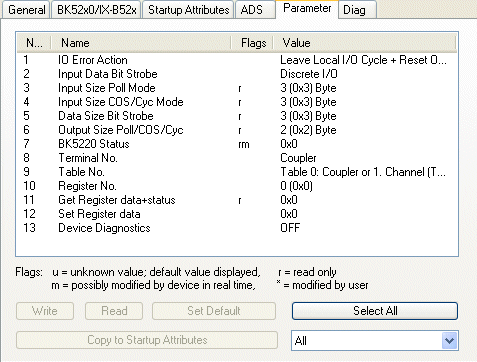Beckhoff DeviceNet Bus Coupler
The Bus Coupler BK52xx and the IPxxx-B520 Fieldbus Box are used in the DeviceNet bus. The specific properties which distinguish them from other Bus Couplers and/or fieldbus box modules are then described below.
Types | Description |
|---|---|
BK5210 | Economy Bus Coupler |
BK5220 | Economy + Bus Coupler |
LC5200 | Low-Cost Bus Coupler |
BK5250 | Compact Bus Coupler |
BC5250 | Compact Bus Terminal Controller with 48 kbyte program memory |
BX5200 | BX Bus Terminal Controller with 256 kbyte program memory |
IPxxxx-B520 | Fieldbus compact box: DeviceNet input/output module in protection class IP67 |
The following tabs are used for parameterization:
“BK52x0” tab

MAC-ID
Sets the MAC ID, i.e. the device address of the DeviceNet device (between 0 and 63). This value must comply with the value set at the Bus Coupler and/or at the compact box.
Cycle time
Sets the cycle time of the IO connection polling and bit strobe. The value is used as “Expected Packet Rate” attribute of the “Connection Object” according to the DeviceNet specification.
Electronic Key
Serves to check the devices within the network at the system StartUp. The electronic key is read from the devices at every system StartUp and compared with the saved configuration.
Polled
Produced/Consumed
Activation of the “Polling” mode, cyclic writing and reading of IO data. Setting of the data content of the data transmitted via the polled IO connections. You can choose from digital data, analog data or both. The selection depends upon the BK52xx terminal arrangement.
Bit-Strobed
Produced/Consumed
Activation of the “Bit Strobe” operating mode. A broadcast message requests all nodes to send their bit strobe message (up to 7 bytes input or status data). Setting of the data content of the data transmitted via the bit-strobed IO connections. You can choose between digital data or diagnostic data.
Change of State / Cyclic
Produced/Consumed
Setting of the data content of the data transmitted via the change of state/cyclical IO connections. You can choose from digital data, analog data or both. The selection depends upon the BK52xx terminal arrangement.
Change of State / Cyclic
Selection of the required operating mode.
Heartbeat-Rate / Send-Rate
In the “Change of State” mode the heartbeat rate gives the cycle time of the cyclical send of the lower-level (i.e. in addition to the event driven) IO data. In “Cyclic” mode the send rate specifies the cycle time with which the IO data are sent.
Inhibit-Time
Delay time in “Change of State” mode; after a change of state IO data are sent after the specified time at the earliest.
Acknowledge Timeout
Time before the retransmission in the event of faulty acknowledgement of a change of state / cyclical message.
Acknowldege Retry Limit
Maximum number of retransmissions until IO connection goes into error mode.
K-Bus update
Calculates the expected time required for a full update of the terminal bus (depends on the connected terminals).
Auto Device Replacement (ADR)
Not supported.
“Startup Attributes” tab

The startup attributes are sent to the slave before the cyclic data exchange. The messages are sent before the actual IO data traffic.
Use the “New” or “Edit” button for configuration:

The attributes are initialized via Class/Instance/Attributes. Note the “Value” specification in hexadecimal form.
“ADS” tab

The node (Bus Coupler) is assigned an ADS port to enable writing and reading of DeviceNet objects at runtime (e.g. from the PLC). It can be changed if required. A detailed description of explicit messages can be found in section “DeviceNet Communication” under “Explicit Messages”.
DeviceNet objects can be accessed via Online Access. To this end the DeviceNet-specific information such as Class/Instance/Attributes has to be entered.
Read
Reading of an object attribute via DeviceNet “Get_Attribute_Single” service. A service ID is not required.
Write
Writing of an object attribute via DeviceNet “Set_Attribute_Single” service. A service ID is not required.
Read/Write
Executing any DeviceNet service. Specification of the service ID is required.
“Parameter” tab

The parameters read from the EDS file are shown under the “Parameters” tab. Parameters can be read, written and entered in the list of the startup parameters.
“Diag” tab

The “Diag” tab indicates the state of the box. No further diagnostic options are available.